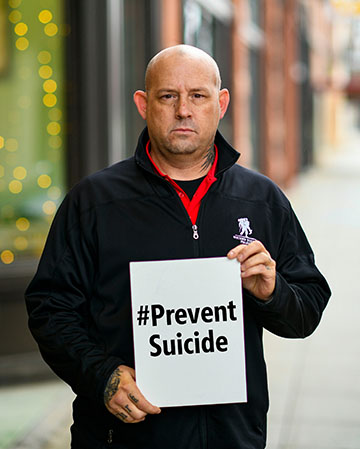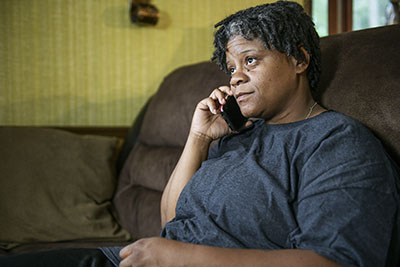Breaking the Stigma: Responses to Common Questions and Debunking Myths About Suicide

Suicide is seldom a topic people feel comfortable talking about, but it’s important to be able to discuss the subject openly in order to combat stigma and help remove obstacles to getting help.
Wounded Warrior Project® (WWP) is committed to helping warriors find the help and care they need to live successful and fulfilling lives. WWP’s 2022 Annual Warrior Survey showed some alarming trends when it comes to mental health and suicidal ideation. According to the survey, more than 1 in 4 warriors served by WWP have had suicidal thoughts in the past 12 months. Of warriors who reported having suicidal thoughts, 72% reported having them in the previous two weeks.
The 2022 Annual Warrior Survey also found:
- About half (51.5%) reported at least one instance of suicidal ideation in their lifetimes.
- Nearly 1 in 5 (18.5%) reported having attempted suicide at least once in their lifetimes.
- Post-traumatic stress disorder (PTSD) military sexual trauma (MST), and substance use were associated with higher rates of suicidal thoughts.
- 76% of warriors reported PTSD and nearly half presented with moderate to severe PTSD symptoms. More than half (54.9%) presented with moderate to severe depressive symptoms.
- 1 in 10 warriors reported experiencing MST during their service. Nearly half of women warriors (44.6%) reported MST.
- More than 2 in 5 warriors (43.5%) screened positive for potential hazardous drinking or active alcohol use disorders.
- More than 6 in 10 warriors (64.2%) indicated they did not have enough money to make ends meet at some point in the past 12 months. Nearly half (46.1%) reported living paycheck to paycheck either sometimes or all the time.
These are just some of the reasons it is so important to make sure veterans know they are not alone, and care is available.
WWP Talk program director Sonal Patel, Ph.D., and members of the WWP Talk team helped answer some common questions about suicide to debunk myths.
1. What are some of the risk factors and warning signs that someone is at risk for attempting suicide?
- Risks and warning signs of suicide can be very different for each individual, but some common signs are isolation from friends, family, and activities they used to enjoy.
- Giving away prized possessions.
- Changes in overall demeanor/behavior compared to how they typically are.
- Feelings of being a burden or that they have no purpose.
- Learning that someone has experienced big changes in their life; could be positive (getting promoted, married, having a baby) or negative (losing a job, divorce, death of loved one).
- Other possible warning signs can include having attempted suicide before, a mental health condition, long-term-pain or terminal illness, financial problems, substance use disorder, researching ways to die, and talking about suicide or making final preparations. For more warning signs, go to https://www.nimh.nih.gov/health/publications/warning-signs-of-suicide.
“There are factors that can make an individual more at risk, such as mental health issues, experiencing physical health problems, or recently receiving information that puts their life in a negative light,” Patel said. “But honestly, anybody can be at risk for suicide because there are not always warning signs.”
2. Veterans have higher suicide rates than the general population. What are some of the specific reasons behind this and what can we do to combat it?
Some issues that particularly affect veterans:
- Isolation.
- Nightmares (sleep problems).
- Flashbacks.
- Severe pain.
- Financial struggles.
- Loss of purpose or feeling as though they are a burden.
- Not asking for help due to stigma.
Some of the best ways to combat these issues include:
- Therapy, such as dialectical behavioral therapy (DBT), cognitive behavioral therapy (CBT), and brief intervention strategies.
- Getting them connected to support groups or something that gives them more meaning.
- Validating feelings and offering support.
“When we think about transitioning [from military to civilian world], it can affect a person’s mood and judgment,” Patel said. “Factors that can affect our mood or judgment could include, looking for a job, not getting or holding a job, or connecting with your family or the people around you. Maybe moving to a new place and being out of a structured environment, and now you have to find where your place is and how that structure looks for you. That can all be overwhelming when it all happens at one time.”
3. Many people, including veterans, worry about seeking mental health care or revealing thoughts of suicide because it could be seen as a weakness. Why is that thinking a myth?
Mental health still has a stigma associated with it. WWP offers many innovative opportunities for warriors to work on their mental health. Asking for help can actually promote feelings of control in an individual's life and allow them to make healthier choices for themselves moving forward.
“It’s important to recognize that an individual can seek help and live a healthy lifestyle, but I believe the stigma around mental health and treatment is still a big factor, especially in the military community,” Patel said. “At Wounded Warrior Project, we are providing services that help our warriors and family support members open up to the idea of seeking help and, in doing so, decreasing that stigma.”
4. Many people feel uncomfortable asking someone if they are thinking about suicide or worried that talking about it will make someone more likely to do it. Why is it important we have this dialogue?
Having this dialogue can be uncomfortable, but it can open the doors for assistance to work through those difficult times. Having this conversation can also give someone relief and the understanding that they are not alone. More importantly, asking this question could save a life.
“We have to be mindful when an individual is in deep psychological pain, we have to put whatever feelings we have aside and reach out,” Patel said. “We have to listen, provide support, and make sure that we can help in any way possible to get them the support they need.”
Debunking Myths of Suicide

Myth: Someone who takes their own life is “cowardly,” “selfish,” or “weak.”
Fact: Someone who completes suicide is in psychological pain and is likely thinking suicide is their only solution. In their mind, they have lost all hope for answers that will help them see beyond the current situation. This myth solidifies that there is still stigma around mental health and suicide, and that suicide is not understood by most. Despite someone’s personal views of suicide, it is important that we all recognize the possible warning signs, ask someone if they are thinking of suicide, and get them connected to resources that can help save their life.
Myth: If someone is talking about taking their life, they are just trying to get attention and won’t actually do it.
Fact: If someone is talking about suicide, they are likely asking for support and they have some hope that they can still live. Talking about suicide can be a plea for help and the individual may also be exhibiting behaviors other than talking about suicide. Someone who is actively thinking about suicide may be at a higher risk in carrying out his/her plan. Any time someone is talking about taking their life, it should be taken seriously.
Myth: Suicide or suicide ideation is caused by mental illness.
Fact: While individuals who struggle with mental illness can experience thoughts or attempts at suicide, it does not necessarily mean that their mental illness caused their suicidal thoughts. Individuals can experience suicidal thoughts by having big life changes (both positive and negative), being isolated and having no support, feeling trapped or stuck, experiencing relationship problems, etc.
Myth: If someone really wants to die, they’ll find a way, and there’s nothing you can do to stop them.
Fact: This can be true in some instances, but most suicides are not sudden or impulsive and there are often many warning signs. If someone has expressed thoughts of suicide or has warning signs, then there is still hope that they can get support and save their life. If there are warning signs, it is important to listen to the individual, ask if they are thinking about suicide, and encourage them to seek support.
Sources: WWP Talk Director Sonal Patel and WWP Talk managers Erika Myers, Nelson Lorenzo, Nicole Saunders, and Reginald Adeogun
Ways WWP Can Help
Wounded Warrior Project’s mission is to honor and empower wounded warriors, and that includes improving overall mental health and reducing the number of veteran suicides. Here are some of the free programs and services WWP offers to help warriors with their mental well-being.

WWP Talk: WWP Talk is a nonclinical, telephonic, emotional support and goal-setting program that breaks down the barriers of isolation. The program helps both warriors and family support members plan individualized paths toward personal growth. “We truly have the ability to meet our warriors and family support members where they are at in their journey,” Patel said.
Warrior Care Network: This is a partnership between WWP and four world-renowned academic medical centers, which focuses on treating veterans with PTSD, traumatic brain injury (TBI), and other related conditions. This two-week accelerated treatment program uses evidence-based clinical treatments and complementary wellness and health services to fast-track the journey to better mental and brain health. Studies show that participants completing the program experience a significant improvement in PTSD and depression symptoms.
Project Odyssey: This is a 12-week mental health program that uses adventure-based learning to help warriors manage and overcome their invisible wounds. Project Odyssey starts with a five-day mental health workshop using nature as a backdrop which allows warriors to take a step back from everyday routines, build connections with fellow warriors, develop coping skills, and achieve goals to improve quality of life.
Peer Support: The WWP Annual Warrior Survey showed that connection with fellow veterans was a big component of a warrior’s mental well-being. Losing that sense of camaraderie can add to feelings of loneliness and isolation. WWP offers peer support groups and connection events across the country that allow warriors to reconnect and bond with other veterans who understand their obstacles and give them a shoulder to lean on.
Family Support: Warriors aren’t the only ones who carry the burdens of their service or the invisible wounds of war. Spouses, children, and parents can also experience secondary symptoms of PTSD and can feel overwhelmed, especially if they are acting as a caregiver. WWP helps family members support the warrior in their lives and supports them directly.
Career and Financial Wellness: Worrying about how to pay the bills can contribute to depression. According to the 2022 Annual Warrior Survey, an overwhelming 64.2% of warriors reported not having enough money to make ends meet at some point in the past 12 months.
WWP has financial education programs to help empower warriors to build a strong financial foundation. Warriors to Work can help warriors and family members find employment, learn skills, and provide career counseling.
Benefits Services: Stress over money and getting earned benefits from the Department of Veterans Affairs (VA) can contribute to mental health issues. WWP Benefits Services VA-accredited representatives can assist warriors with filing for VA benefits, including health care benefits, disability compensation, and caregiver benefits.
It’s important veterans and their loved ones know that there is help out there, and there is strength in reaching out. You don’t have to do this alone.
Learn more about veteran suicide prevention and how WWP can help.
If you or someone you know is struggling with thoughts of suicide, contact the Veterans Crisis Line by dialing 988 (press 1), or texting 838255.
Contact: Paris Moulden – Public Relations, pmoulden@woundedwarriorproject.org, 904.570-7910
About Wounded Warrior Project
Since 2003, Wounded Warrior Project® (WWP) has been meeting the growing needs of warriors, their families, and caregivers — helping them achieve their highest ambition. www.woundedwarriorproject.org